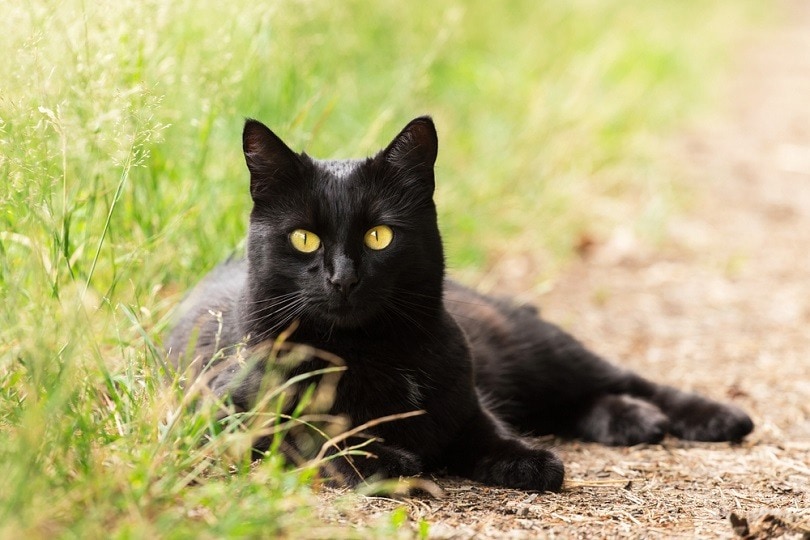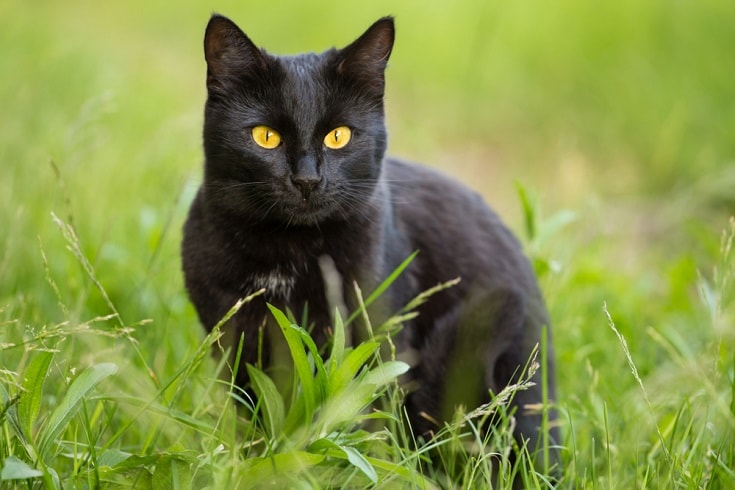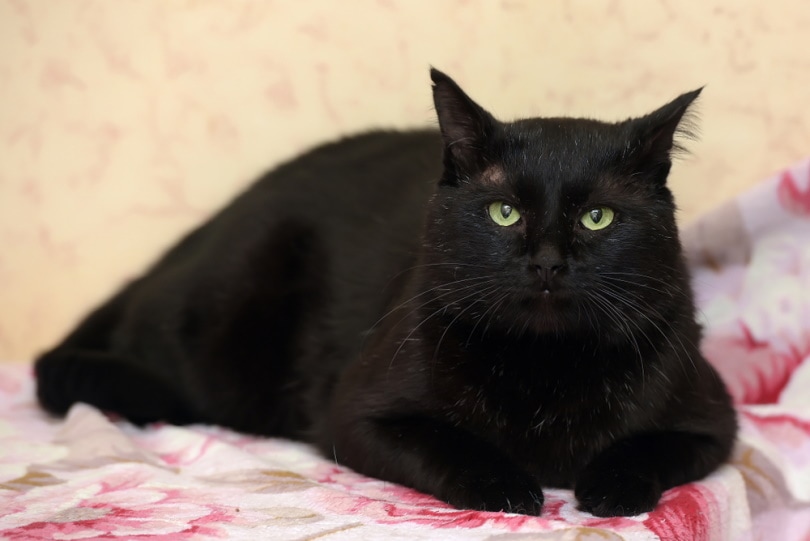
The Bombay cat is a hybrid cat breed with Sable Burmese and Black American Shorthair parents. The look that’s achieved with this cross is a mini panther-like body with golden or copper eyes.
Like wild panthers, Bombays also love to climb and observe from high perches. However, they have very warm and affectionate personalities and make wonderful pets.
Bombays are relatively healthy pets, but they can be prone to some concerns. It’s important to understand different diseases and illnesses a Bombay is susceptible to so that you can best monitor their health and know which warning signs to look for in your cat. Here are some health concerns that may develop, especially as your Bombay ages.
Top 5 Bombay Cat Health Problems
1. Craniofacial Defect (Burmese Head Defect)
| Common Signs and Symptoms | Abnormal skull shape or facial features, malformed lower jaw, brachycephalic head |
| Life Stage Affected | Birth |
| Treatment Available | No |
The craniofacial defect can be traced to the Burmese cat. This feature is due to a genetic mutation that causes malformation of the skull and face. Because it develops while the cat is a fetus, it’s spotted immediately after the kitten’s birth. They’re often very severe and can appear as malformed jaws and nostrils and brain protrusions.
Cats can carry one or two of these mutated genes. Kittens that have two of these genes are the ones that have severe birth defects and are often euthanized. Bombays that possess one mutated gene will have a brachycephalic head, and they’ll end up having a short muzzle. There is a genetic test available.

2. Hypertrophic Cardiomyopathy
| Common Signs and Symptoms | Difficulty breathing, congestive heart failure |
| Life Stage Affected | Adult, Senior |
| Treatment Available | Yes |
Hypertrophic Cardiomyopathy (HCM) is a common health concern that many different cat breeds can develop. A Bombay can develop HCM when the muscle of the heart’s left ventricle thickens. This thickening eventually causes the heart to run inefficiently and triggers other health concerns in the body.
Cats with HCM will eventually experience difficulty breathing and congestive heart failure and sadly sometimes sudden death. There’s no known cure for HCM and treatment targets symptoms, such as managing heart rate and preventing blood clots from forming.
Reputable breeders will test their kittens for HCM and will not sell any that have the genes. If a breeder tries to sell you a kitten that hasn’t been tested or is resistant to showing health records, you can leave that breeder and find a different one.
3. Aortic Thromboembolism
| Common Signs and Symptoms | Sudden paralysis, weakness in rear legs, difficulty breathing, lower body temperature |
| Life Stage Affected | Adult, Senior |
| Treatment Available | Yes |
Aortic Thromboembolism (ATE) is a dangerous condition in which a blood clot travels through the aorta and gets stuck in the blood vessel. This causes blood flow to slow down significantly and prevents oxygen from being transported to areas beyond the clot.
Cats with heart disease are most at risk of ATE and while it can occur with kittens and young adult cats, it’s most prevalent in older adults and senior cats.
While some treatment is available to help cats recover from an ATE episode, the general prognosis isn’t very bright. Most cats will redevelop a blood clot and may have to be on anti-blood clotting medication and under regular re-evaluation for new blood clots.

4. Obesity
| Common Signs and Symptoms | Loss of visible waistline, lethargy, loss of mobility |
| Life Stage Affected | All life stages |
| Treatment Available | Yes |
Feline obesity is becoming a more prominent issue in the US, and about 50% of cats seen by veterinarians are overweight. Indoor cats can be more prone to obesity because they typically aren’t as active as outdoor cats. They also have more access to food and can be overfed.
Obesity can lead to other significant health issues, such as arthritis, endocrine and metabolic disorders, and a weakened immune system. So, it can drastically reduce a cat’s quality of life.
While cats of all ages can become obese, middle-aged cats between 8-12 years old are more susceptible to obesity.
The main way to treat obesity is to target the cat’s diet. A veterinarian may prescribe a special diet and reduce the cat’s caloric intake. The cat will also need more opportunities to exercise and will have to be introduced to more activities in increments to prevent injury.
5. Hypokalaemia
| Common Signs and Symptoms | Weakness, difficulty walking and keeping head up |
| Life Stage Affected | Lifelong |
| Treatment Available | Medication |
Burmese hypokalemia is an inherited disorder that is also seen in the Bombay cat lines. It results in intermittently low potassium causing muscular weakness and difficulties walking. It normally becomes evident in young kittens around two to six months of age and will affect them lifelong. There is no cure but treatment can help.

How To Help Your Bombay Cat Stay Healthy
While there’s no guarantee that your Bombay cat will live a life free of illness, there are some steps that you can take to reduce the risk of your cat developing a chronic or fatal condition.
First, make sure to be on top of scheduling routine visits and preventative health care with your veterinarian. Building a relationship with your veterinarian is vital because your veterinarian will be able to monitor and check for any warning signs and symptoms of underlying illnesses. They can also provide extremely helpful information related to your cat’s physical wellbeing.
Next, make sure that your cat’s receiving the proper nutrition for its life stage. Your veterinarian can help you determine the correct diet and portions of food to give to your Bombay cat. Also, make sure to only provide an appropriate amount of treats, and don’t feed your cat any human snacks or junk food. Cats can quickly become overweight by consuming too many snacks.
Cats also need to exercise daily. Exercise benefits both their physical and mental health because it expends their energy and keeps them from boredom. Make sure to provide plenty of toys that will encourage your cat to stay active and entertained.
Conclusion
In general, Bombay cats are pretty healthy and don’t have too many health concerns beyond those that all cats can have, such as parasites and infectious disease. However, some cats may be susceptible to developing certain genetic diseases. So, make sure to work with your vet to monitor your cat’s health so that you can increase the likelihood of detecting any conditions in the early stages. It’s best to be proactive and preventative rather than reactive towards any diseases or illnesses.
You may also be interested in:
- Burmese Cat Health Problems: 10 Common Concerns
- Bengal Cat Health Problems: 14 Vet Reviewed Concerns
Featured Image Credit: Viktor Sergeevich, Shutterstock





